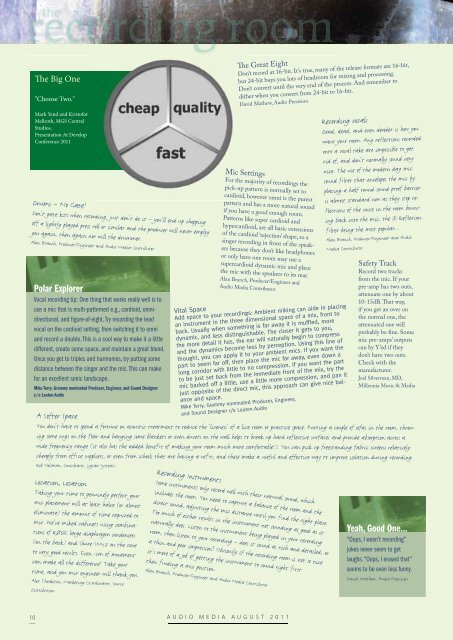Download - Audio Media
Download - Audio Media
Download - Audio Media
You also want an ePaper? Increase the reach of your titles
YUMPU automatically turns print PDFs into web optimized ePapers that Google loves.
ecording theroomThe Big One"Choose Two."Mark Yend and KristoforMellroth, MGS CentralStudios,Presentation At DevelopConference 2011Drums – No Gate!Don’t gate kits when recording, just don’t do it – you’ll end up choppingoff a lightly played press roll or similar and the producer will never employyou again, then again nor will the drummer.Alan Branch, Producer/Engineer and <strong>Audio</strong> <strong>Media</strong> ContributorPolar ExplorerVocal recording tip: One thing that works really well is touse a mic that is multi-patterned e.g., cardioid, omnidirectional,and figure-of-eight. Try recording the leadvocal on the cardioid setting, then switching it to omniand record a double. This is a cool way to make it a littledifferent, create some space, and maintain a great blend.Once you get to triples and harmonies, try putting somedistance between the singer and the mic. This can makefor an excellent sonic landscape.Mike Terry, Grammy nominated Producer, Engineer, and Sound Designerc/o Lauten <strong>Audio</strong>A Softer SpaceLocation, LocationTaking your time to genuinely perfect yourmic placement will at least halve (or almosteliminate) the amount of time required tomix. We’ve miked cabinets using combinationsof RØDE large diaphragm condensers(on the back) and Shure SM57 on the coneto very good results. Even 1cm of movementcan make all the difference! Take yourtime, and you mix engineer will thank you.Alex Theakston, Marketing Co-ordinator, SourceDistributionVital SpaceRecording InstrumentsThe Great EightSome instruments only record well with their natural sound, whichincludes the room. You need to capture a balance of the room and thedirect sound, adjusting the mic distance until you find the right place.Too much of either results in the instrument not sounding as good as itnaturally does. Listen to the instrument being played in your recordingroom, then listen to your recording – does it sound as rich and detailed, ora thin and poor impression? Obviously if the recording room is not so niceit’s more of a job of getting the instrument to sound right firstthen finding a mic position.Alan Branch, Producer/Engineer and <strong>Audio</strong> <strong>Media</strong> ContributorDon’t record at 16-bit. It’s true, many of the release formats are 16-bit,but 24-bit buys you lots of headroom for mixing and processing.Don’t convert until the very end of the process. And remember todither when you convert from 24-bit to 16-bit.David Mathew, <strong>Audio</strong> PrecisionMic SettingsFor the majority of recordings thepick-up pattern is normally set tocardioid, however omni is the purestpattern and has a more natural soundif you have a good enough room.Patterns like super cardioid andhypercardioid, are all basic extensionsof the cardioid ‘rejection’ shape, so asinger recording in front of the speakersbecause they don’t like headphonesor only have one room may use asupercardioid dynamic mic and placethe mic with the speakers to its rear.Alan Branch, Producer/Engineer and<strong>Audio</strong> <strong>Media</strong> ContributorRecording vocalsAdd space to your recordings: Ambient miking can aide in placingan instrument in the three dimensional space of a mix, front toback. Usually when something is far away it is muffled, moredynamic, and less distinguishable. The closer it gets to you,the more detail it has, the ear will naturally begin to compressand the dynamics become less by perception. Using this line ofthought, you can apply it to your ambient mics. If you want thepart to seem far off, then place the mic far away, even down along corridor with little to no compression. If you want the partto be just set back from the immediate front of the mix, try themic backed off a little, use a little more compression, and pan itjust opposite of the direct mic, this approach can give nice balanceand space.Mike Terry, Grammy nominated Producer, Engineer,and Sound Designer c/o Lauten <strong>Audio</strong>Dead, dead, and even deader is how youwant your room. Any reflections recordedonto a vocal take are impossible to getrid of, and don’t normally sound verynice. The use of the modern day micsound filter that envelopes the mic byplacing a half round sound proof barrieris almost standard now as they stop reflectionsof the voice in the room bouncingback into the mic, the sE Reflexionfilter being the most popular...Alan Branch, Producer/Engineer and <strong>Audio</strong><strong>Media</strong> ContributorSafety TrackRecord two tracksfrom the mic. If yourpre-amp has two outs,attenuate one by about10-15dB. That way,if you get an over onthe normal one, theattenuated one willprobably be fine. Somemic pre-amps’ outputscan by Y’ed if theydon’t have two outs.Check with themanufacturer.Joel Silverman, MD,Millennia Music & <strong>Media</strong>You don’t have to spend a fortune on acoustic treatment to reduce the ‘liveness’ of a live room or practice space. Putting a couple of sofas in the room, throwingsome rugs on the floor and hanging some blankets or even duvets on the wall helps to break up hard reflective surfaces and provide absorption across awide frequency range (it also has the added benefit of making your room much more comfortable!). You can pick up freestanding fabric screens relativelycheaply from office suppliers, or even from schools that are having a refit, and these make a useful and effective way to improve isolation during recording.Rob Holsman, Consultant, Jigsaw SystemsYeah, Good One...“Oops, I wasn’t recording”jokes never seem to getlaughs. “Oops, I erased that”seems to be even less funny.David Mathew, <strong>Audio</strong> Precision10AUDIO MEDIA AUGUST 2011















